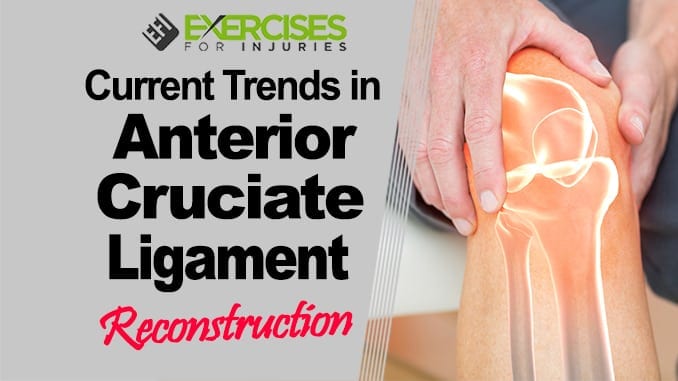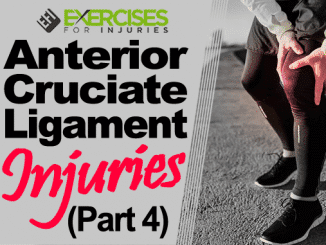
What is Anterior Cruciate Ligament Injury?
An anterior cruciate ligament (ACL) injury is usually the result of a sudden twisting motion, such as in a football or soccer game. A forceful rotation or overstretching can tear an ACL. These occurrences usually happen during sports that involve frequent pivoting and turning movements.
The ACL is a narrow band of tissue that runs from the femur head to the tibia.
Many people neglect to treat their existing customers as the most critical component of their business when they are eager to attract new clients. The most common symptom of an ACL tear is knee pain. Pain may also be present during or after physical activity.
X-rays may reveal other knee problems, such as meniscus tears or joint cartilage damage. A doctor performs a physical examination to diagnose this injury.
The anterior cruciate ligament (ACL) is a band of tissue that helps to stabilize the knee. The most common sports that involve an ACL injury are football and soccer. An injured person with an ACL injury can lead a whole life still and have enjoyable activities after surgery. Keep reading for those who want to learn more about anterior cruciate ligament reconstruction and what they should know!
ACL Survey Results
In 2006, a survey regarding anterior cruciate ligament (ACL) reconstruction was mailed to the American Orthopaedic Society for Sports Medicine physicians. Nine hundred ninety-three responses were received from 1747 possible respondents (57%). The number of ACL reconstructions per year ranged from 1 to 275 (mean = 55).
The most critical factors in the timing of surgery were knee range of motion and effusion. Bone-patellar tendon-bone (BPTB) autograft was most commonly preferred (46%), followed by hamstring tendon autograft (32%) and allografts (22%).
A study conducted five years ago revealed that BPTB grafts were less frequent (63%) than allografts (25%). 90% of surgeons perform arthroscopic surgery using a single incision. Most allowed return to total activity at 5 to 6 months, with a trend toward earlier return for BPTB grafts; quadriceps strength was an essential factor in the decision. There was a limited experience (4%) with double-bundle and computer-assisted ACL reconstruction.
Arthroscopic-assisted, single-incision reconstruction using a BPTB autograft fixed with metal interference screws remains the most common technique for primary ACL reconstruction. In the past five years, the use of alternative graft sources and methods of fixation has increased. Consensus regarding the best graft type, fixation method, and postoperative protocol is still lacking.
Current Trends in Anterior Cruciate Ligament
The anterior cruciate ligament (ACL) is a band of tissue that stabilizes the knee. Injuries to the ACL happen when the knee twists or bends, such as from a fall or tackle during football or a slide tackle in soccer. The most common sports are football and soccer.
Why Surgery?
A torn ACL can lead to pain, instability, and a decreased range of motion in the knee. The most common symptom of a torn ACL is an audible “pop.” There are several surgical treatments for ACL injuries. One option is to wait and see if the injury heals on its own, which often causes permanent damage to the knee joint. Another option is surgery, which is becoming more popular with better ACL reconstruction methods.
Surgery for an ACL injury should be considered if someone wants their knee to function properly again. If you find yourself in this situation, here are six reasons surgery may be best for you.
1. Return to Normal Function
The ACL is one of the major ligaments that help stabilize the knee joint, so if it is torn, surgery can help you regain stability and strength in your knee. The most common reason to have ACL surgery is to improve your ability to move your knee. This can be important if you need to engage in activities like running or jumping.
2. Decrease the Risk of Injury to Other Knee Ligaments
A torn ACL often leads to instability in the knee joint, which can lead to other injuries. This is because the muscles and other ligaments around the knee common are not strong enough to compensate for a torn ACL. Without a standard ACL, these other ligaments become strained and injured more efficiently, increasing your risk for meniscus tears and cartilage damage in the knee joint. If you want to prevent further injuries from occurring, it may be best for you to have surgery on your torn ACL as soon as possible.
3. Decrease the Risk of Injury to the Knee Joint
A torn ACL can damage the knee joint, resulting in arthritis and pain over time. Surgery may be best for you if you want a reduced risk of joint damage from a torn ACL. Surgery can help prevent further injury to your knee joint because it stabilizes the knee and improves its overall function.
4. Increase Your Ability to Return to an Active Lifestyle
A torn ACL is often associated with decreased mobility, stamina, and physical activity, which is why many people choose surgery to return to their active lifestyles as soon as possible. The most common types of surgery for an ACL tear include a patella tendon graft or hamstring tendon graft. These surgeries allow you to regain some strength and function you enjoyed before your injury.
5. Decrease Pain Associated with a Torn ACL
Pain is often one of the most common symptoms of a torn ACL, and surgery can help decrease the pain you experience. This is because the torn ACL will be removed from your knee, eliminating contact between the knee and your other ligaments. Without this contact, your other ligaments will not be strained as much, which may decrease the pain you feel in your knee.
6. Decrease Risk of an ACL Rupture in Future
If you choose to have surgery on a torn ACL, you may be able to decrease your risk of future injuries to this ligament. That’s because surgery helps stabilize the knee joint, which can limit how much it moves around during sports and other physical activities. If you want to reduce your risk of another torn ACL injury, it may be best to choose surgery over nonsurgical treatment options like physical therapy or bracing.
What to Expect After Surgery?
It is essential to plan to make sure that your doctor knows about any prescriptions, over-the-counter medications, supplements, or herbal remedies you are taking. This will help them know if there may be a problem with the combination of these medicines and what side effects they can have on the surgery patient’s healing process. It is also helpful for doctors to note which vegetables are safe so they don’t delay recovery by insisting on an unnecessary 6-week post-op diet restriction period before patients can eat common high fiber foods like broccoli and cauliflower.”
“When it comes time for physical therapy after ACL reconstruction, there are many options available such as pool exercises at home or swimming laps in a local community center’s lap pool; stationary bike workouts; weight lifting using weights designed specifically for use during rehabilitation from ACL reconstructive surgery (rehab weights); walking/jogging using special braces called “CPMs”; quadriceps strengthening exercises performed against resistance bands attached around one’s ankles while seated on firm ground holding onto sturdy objects).”
There are many ways to recover from ACL reconstruction surgery, but one thing is for sure: after surgery, you will still be able to lead a whole life with enjoyable activities!
CLICK HERE to watch the YouTube video
Rick Kaselj – [email protected]
Registered Kinesiologist Specializing in Injury Rehabilitation
Surrey, BC, Canada






